JAPAN:† FROM DEFEATED
NATION TO ECONOMIC POWER
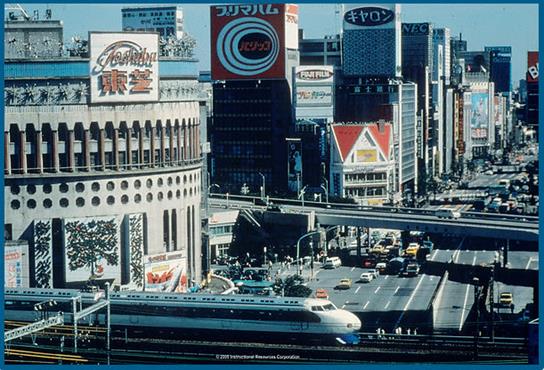
The Ginza District:† Tokyo, Japan
Unit
Overview
World
War II left Japan a devastated nation, and the countryís future appeared
bleak.† American occupation, however,
redirected the nationís focus from military expansion to democratic capitalism.† This put Japan on a course that resulted in a
remarkable economic recovery.† The global
conditions in the 1990s, however, shook Japanese confidence in their continuing
success.† Letís see how it all happened.

STOP:† Answer Section A Questions
Post-war
Occupation
When
American occupation forces arrived in Japan in 1945, they found massive wartime
destruction.† More than half of the
private homes in Japanís major cities had been destroyed, and the countryís
factories had been reduced to rubble.†
Thousands of Japanese were starving and had no source of income.† General
Douglas MacArthur and his American staff directed the occupation and
established two main goalsóto dismantle the Japanese armed forces and to
establish a democratic government.† To
achieve the first objective, an international
tribunal tried Japanese military leaders accused of wartime atrocities.† These proceedings further discredited Japanís
military establishment.† In 1946, Japan
adopted a new constitution and became a constitutional
monarchy.† Representatives were
elected to the Diet, a legislative
body similar to a parliament.† The
emperor became a figurehead with no political power.† The Japanese constitution guaranteed certain
freedoms reminiscent of those listed in the American Bill of Rights.

Formal Surrender of Japan on the U.S.S.
Missouri:† 1945
Occupation
forces also tried to bring about social and economic reform.† They stressed the importance of legal rights
for women and an educational system that was open to all citizens.† Women had previously been treated more like children were now equals and granted voting rights. New agricultural policies compensated the
owners of large estates to divide their lands among peasant farmers.† This permitted many Japanese people to own
property for the first time.†† Japanís
constitution defended the right of workers to join unions.† However, the Japanese resisted American
efforts to outlaw large business organizations known as zaibatsu on the grounds that they were necessary to keep Japan
competitive in the global market.
STOP:† Answer Section B Questions
Japan
and the Cold War
The establishment
of a communist government in China in 1949 changed the way Americans viewed
Japan.† As the Cold War intensified, the United States recognized the advantage of
having Japan as a strong, Asian ally rather than as an occupied subject.†† In 1952, the United States and Japan signed the
Treaty of San Francisco that ended American post-war supervision.† It did, however, permit the U.S. to keep its
military complex in Japan.† This made
Japan Americaís chief supporter against the advance of communism in the
Pacific.
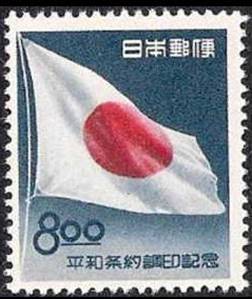
Stamp Issued by the Japanese Government
to Commemorate the Treaty of San Francisco
†
The Cold War also led the United States to question a provision in Japanís constitution that prohibited the Pacific nation from maintaining armed forces.† Known as Article 9, this measure met with American approval because it reinforced Japanís shift from militarism to democracy.† However, as Asian nations, such North Korea and China, established communist governments, the United States saw an advantage in a rearmed Japan.† For this reason, the U.S. encouraged the development of Japanís Self Defense Forces (JSDF) as a peacekeeping military.† Recent tensions with North Korea resulted in a reinterpretation of Article 9 in 2014.† This change permitted the use of the JSDF to defend Japanís allies in response to declarations of war.
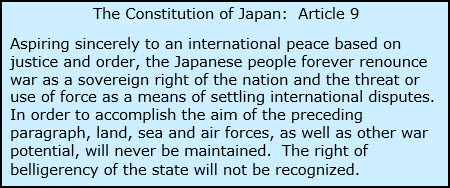
STOP:† Answer Section C Questions
Japanís
Economic Comeback
As a
U.S. ally in the Cold War, Japan served as a base for American military
operations during the Korean War.† This brought massive amounts of aid and
billions of dollars in military contracts for Japan.† As a result, the Japanese economy grew 10%
annually from 1950 through 1970.† Japanís
financial strength was built on the production of goods for export.† At first, textiles composed the bulk of the Japanese products sold overseas.† By 1960, however, steel for ships and
machinery became the main focus.†
Japanese cameras, cars and televisions flooded world markets during the
1970s.† Japanese businesses also embraced
the digital technology trend and were soon competing with American-made
electronics.† †
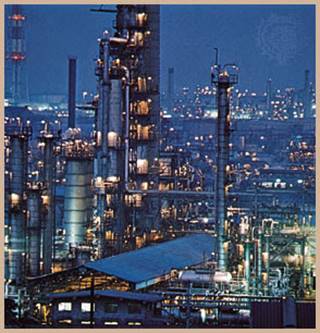
One of Japan's Industrial Zones
A
number of factors contributed to Japanís success in the worldís markets.† The devastation of World War II forced the
country to rebuild its manufacturing plants from scratch.† They were constructed to operate efficiently
and to incorporate the latest equipment.†
This enabled Japan to surpass the output of the Westís older facilities.† An educated and skilled workforce was a
valuable asset for Japanese industry.†
Some companies rewarded their workers with a guarantee of lifetime
employment, a tactic which encouraged loyalty and dedication among their
employees.† The Japanese tended to save a
portion of their paycheck.† This gave
banks the necessary funds to loan to businesses for improvements and expansion.
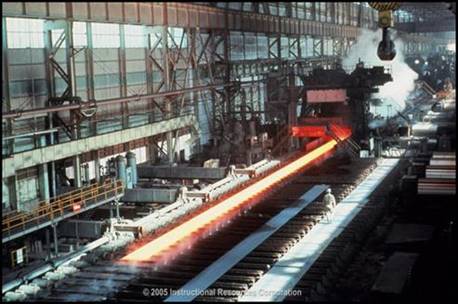
Rolling
Hot Steel in Japan
For
Japan, trade became an economic lifeline.†
The island nationís lack of natural resources forced Japan to import
oil, iron and other raw materials.†
Nevertheless, it was able to export finished products like steel at a
profit.† This enabled the Japanese to
build a positive trade balance in spite of its large number of imports.† As its economy flourished, Japan invested in
projects around the globe.† The Japanese
purchased mines in Africa, plantations in Asia and real estate in North
America.† At the same time, the Japanese
government placed high tariffs on
foreign goods coming into the country to protect its home industries.† Because these decisions created trade
deficits in some cases, this frustrated Japanís trading partners.† For example, the number of Japanese cars
purchased by Americans was viewed as a threat to the U.S. auto industry.† This led to trade talks between the United
States and Japan, but these discussions have only brought limited success.
STOP:† Answer Section D Questions
The
Economic Slowdown
Japanís
economic advancement underwent a sharp setback in the 1990s, and the country
faced a serious financial depression.† In
great part, this was a result of the Japanese dependency on imported raw
materials.† Oil from the Middle East was
essential to the Japanese economy.† OPECís (Oil Producing and Exporting
Countries) price hikes that began in the 1970s rattled the nationís financial
sector.† This led to a slowdown in
manufacturing, a major increase in unemployment and a lack of confidence in the
government to cope with the crisis.†
Between 1990 and 1992, stock prices on the Japanese exchange fell
65%.† At the same time, Japan also faced
increasing competition from other Asian nations for American and European
markets.† Although Japanís economy has
shown some signs of revitalizing, it still faces a number of long-term problems.† These include an aging population, a lack of
usable land and government debt due to deficit
spending.
STOP:† Answer Section E Questions
The
Problem of Overcrowded Cities
Today,
only 20% of Japanese citizens live in rural areas.† The remaining inhabit cities that have become
increasingly overcrowded.† Although Japan
enjoys a relatively low urban crime rate, the lack of space has encouraged some
Japanese to move to the suburbs.†
Unfortunately, commutes, even by high-speed trains, from home to work
are usually long and time-consuming.†
Earthquakes, which are common in Japan, are a serious concern for
densely populated, urban areas.† Highways
and buildings have been built with new technology to minimize the effects of
these natural disasters.† Sometimes even
the best advance planning and modern construction techniques cannot prevent the
negative consequences of a major quake, such as the one that struck Kobe in 1995.† Damage from this earthquake alone was
estimated at over 50 billion dollars.† An
earthquake can also result in a tsunami.†
In 2011, a 9.1 earthquake off the coast of Japan triggered the Tohoku Tsunami.† This devastating natural disaster caused the
deaths of over 15,000 people, damaged or destroyed one million buildings and
resulted in costs totaling $350 billion dollars.
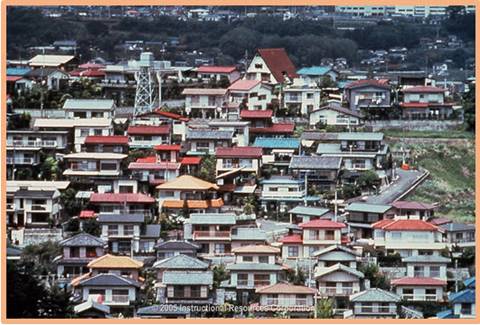
A Community in Suburban Japan
As
in other industrialized countries, pollution of air and water has become a
major concern in Japan.† Thousands of
factories and millions of automobiles have created dangerous levels of smog,
especially along the Tokaido Corridor.† This very busy transportation network that
includes a major highway and two high-speed rail systems connects the capital
city of Tokyo and the city of Kyoto.†
In the 1960s, the severity of water contamination was exposed when
several people died from eating fish that had absorbed large amounts of mercury
due to the industrial dumping of chemicals into Minamata Bay.† The Japanese
government has made great strides in reducing these environmental threats, but
the situation requires constant monitoring.
STOP:† Answer Section F Questions
What
Does It All Mean?
Before
World War II, Japan was regarded as one of the worldís leading industrial
nations, but the war destroyed the countryís infrastructure and drained its
manufacturing capacity.† The American
occupation focused Japanís energy on rebuilding economically and establishing a
democratic government.† Japan proved to
be a valuable U.S. ally in the Cold War and served as a base of operations
during the Korean War.† American military
aid and military contracts sparked the Japanese economy and instigated a
pattern of economic growth that extended for decades.† On the other side of the world, Western
Europe also faced traumatic political and economic conditions, but it, too,
would experience an amazing recovery.
Additional Resources and Activities

Tsunami Disaster Area to Host Olympic Baseball and Softball
Article and Quiz
How Hiroshima Rose from the Ashes Article and Quiz